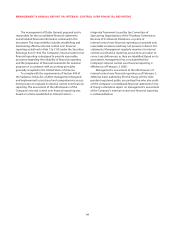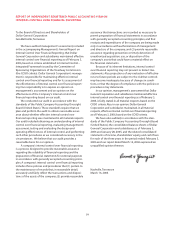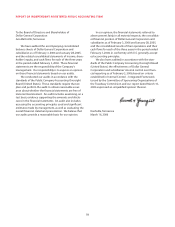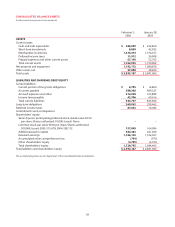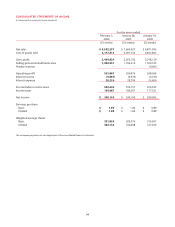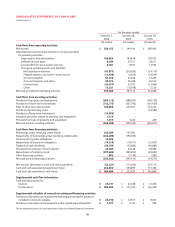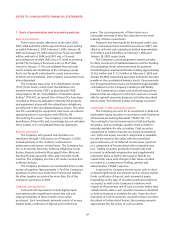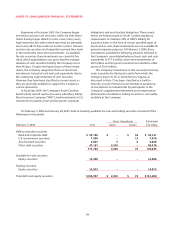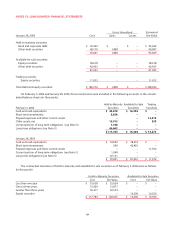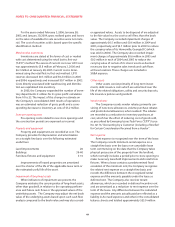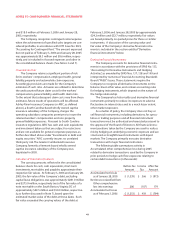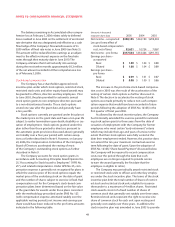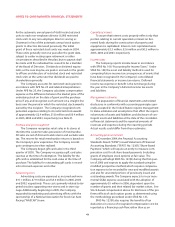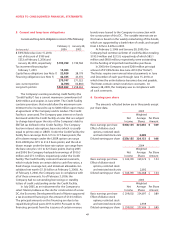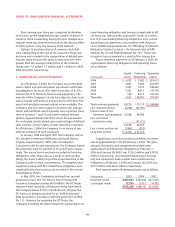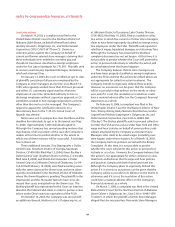Dollar General 2005 Annual Report Download - page 44
Download and view the complete annual report
Please find page 44 of the 2005 Dollar General annual report below. You can navigate through the pages in the report by either clicking on the pages listed below, or by using the keyword search tool below to find specific information within the annual report.
40
NOTES TO CONSOLIDATED FINANCIAL STATEMENTS
For the years ended February 3, 2006, January 28,
2005, and January 30, 2004, gross realized gains and losses
on the sales of available-for-sale securities were not mate-
rial. The cost of securities sold is based upon the specific
identification method.
Merchandise inventories
Inventories are stated at the lower of cost or market
with cost determined using the retail last-in, first-out
(“LIFO”) method.The excess of current cost over LIFO cost
was approximately $5.8 million at February 3, 2006 and
$6.3 million at January 28, 2005. Current cost is deter-
mined using the retail first-in, first-out method. LIFO
reserves decreased $0.5 million and $0.2 million in 2005
and 2004, respectively, and increased $0.7 million in 2003.
Costs directly associated with warehousing and distribu-
tion are capitalized into inventory.
In 2005, the Company expanded the number of inven-
tory departments it utilizes for its gross profit calculation
from 10 to 23.The impact of this change in estimate on
the Company’s consolidated 2005 results of operations
was an estimated reduction of gross profit and a corre-
sponding decrease to inventory, at cost, of $5.2 million.
Store pre-opening costs
Pre-opening costs related to new store openings and
the construction periods are expensed as incurred.
Property and equipment
Property and equipment are recorded at cost. The
Company provides for depreciation and amortization
on a straight-line basis over the following estimated
useful lives:
Land improvements 20
Buildings 39-40
Furniture, fixtures and equipment 3-10
Improvements of leased properties are amortized
over the shorter of the life of the applicable lease term or
the estimated useful life of the asset.
Impairment of long-lived assets
When indicators of impairment are present, the
Company evaluates the carrying value of long-lived assets,
other than goodwill, in relation to the operating perform-
ance and future cash flows or the appraised values of the
underlying assets. The Company may adjust the net book
value of the underlying assets based upon such cash flow
analysis compared to the book value and may also consid-
er appraised values. Assets to be disposed of are adjusted
to the fair value less the cost to sell if less than the book
value. The Company recorded impairment charges of
approximately $0.5 million and $0.6 million in 2004 and
2003, respectively, and $4.7 million prior to 2003 to reduce
the carrying value of its Homerville, Georgia DC (which
was sold in 2004). The Company also recorded impair-
ment charges of approximately $0.6 million in 2005 and
$0.2 million in each of 2004 and 2003 to reduce the
carrying value of certain of its stores’ assets as deemed
necessary due to negative sales trends and cash flows
at these locations.These charges are included in
SG&A expense.
Other assets
Other assets consist primarily of long-term invest-
ments, debt issuance costs which are amortized over the
life of the related obligations,utility and security deposits,
life insurance policies and goodwill.
Vendor rebates
The Company records vendor rebates, primarily con-
sisting of new store allowances, volume purchase rebates
and promotional allowances, when realized. The rebates
are recorded as a reduction to inventory purchases, at
cost, which has the effect of reducing cost of goods sold,
as prescribed by Emerging Issues Task Force (“EITF”) Issue
No. 02-16,“Accounting by a Customer (including a Reseller)
for Certain Consideration Received from a Vendor”.
Rent expense
Rent expense is recognized over the term of the lease.
The Company records minimum rental expense on a
straight-line basis over the base, non-cancelable lease
term commencing on the date that the Company takes
physical possession of the property from the landlord,
which normally includes a period prior to store opening to
make necessary leasehold improvements and install store
fixtures. When a lease contains a predetermined fixed
escalation of the minimum rent, the Company recognizes
the related rent expense on a straight-line basis and
records the difference between the recognized rental
expense and the amounts payable under the lease as
deferred rent. The Company also receives tenant
allowances, which are recorded in deferred incentive rent
and are amortized as a reduction to rent expense over the
term of the lease. Any difference between the calculated
expense and the amounts actually paid are reflected as a
liability in Accrued expenses and other in the consolidated
balance sheets and totaled approximately $25.0 million


